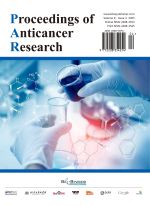Study on the Preparation of Doxorubicin Hydrochloride Liposomes and Their Therapeutic Effect on Liver Cancer
Abstract
Objective: This study aimed to prepare doxorubicin hydrochloride liposomes and explore their application value in patients with liver cancer. Methods: Doxorubicin hydrochloride liposomes were prepared using the ammonium sulfate gradient method. Doxorubicin, as a broad-spectrum antitumor drug, has significant toxic and side effects after toxicological investigation. After preparing DOX-Lip, single-factor analysis was used to analyze the effects of solution pH, number of ultrafiltration, oil-water ratio, incubation temperature, and time on the encapsulation efficiency of doxorubicin hydrochloride liposomes. The process was optimized through orthogonal experiments and then applied clinically. 110 patients with liver cancer were selected as the research subjects to verify the drug’s effectiveness. Results: The results of this study showed that under optimal process conditions, the prepared doxorubicin hydrochloride liposomes were evenly distributed, similar to spherical shapes, with an average particle size of 85–87 mm and a Zeta potential of 15–16 mV, indicating good encapsulation efficiency. The application of these liposomes to clinical treatment of liver cancer demonstrated good therapeutic effects and could effectively promote favorable patient prognosis. Conclusion: The doxorubicin hydrochloride liposomes prepared through process optimization exhibit strong stability and pronounced sustained-release characteristics, providing a solid foundation for the treatment of liver cancer.
References
Zhao Y, Wang H, Jin L, 2025, Pharmacokinetics and Pharmacodynamics of Doxorubicin Hydrochloride Liposomes Combined With Iodinated Oil for Hepatic Arterial Embolization in the Treatment of Rabbit VX2 Liver Cancer. Chinese Journal of Interventional Imaging and Therapy, 22(2): 127–130.
Duan C, Zhang H, 2022, Clinical Study of Doxorubicin Hydrochloride Liposomes in the Treatment of Advanced Hepatocellular Carcinoma. Clinical Research, 30(3): 80–83.
Xu Y, Tong F, Guo Y, et al., 2021, Analysis of Adverse Reactions and Nursing Intervention of TACE Infusion of Doxorubicin Hydrochloride Liposome Injection in Patients With Liver Cancer. Contemporary Medicine, 27(5): 51–54.
Yu Z, Xue H, Qiu L, et al., 2019, Study on the Combined Delivery of Doxorubicin Hydrochloride and miR-375 by Lipid-Hollow Mesoporous Silica for the Treatment of Liver Cancer. Acta Pharmaceutica Sinica, 54(1): 151–158.
Wang Q, Yue Z, Pan Y, 2024, Preparation and In Vitro Release Study of Doxorubicin Hydrochloride Liposomes. Strait Pharmaceutical Journal, 36(2): 9–13.
Yin J, Li L, Meng M, et al., 2022, Safety Evaluation of Clinical Application of Doxorubicin Hydrochloride Liposomes. China Pharmaceutical Industry, 31(16): 115–119.
Shi S, Jia D, Han J, et al., 2024, Effect of Hand-Foot Hypothermia Method on Preventing Hand-Foot Syndrome Induced by Doxorubicin Hydrochloride Liposomes. Clinical Focus, 39(6): 537–541.
Meng H, Zhu S, Zhang W, et al., 2023, Methodological Verification of Pyrogen Test for Doxorubicin Hydrochloride Liposome Injection. Strait Pharmaceutical Journal, 35(11): 33–35.
Shi J, Xie Z, Yang H, 2024, A Case Report and Literature Review of Intertrigo Type IV Hand-Foot Syndrome With Infection Caused by Doxorubicin Hydrochloride Liposomes. Oncology Pharmacy, 14(6): 774–780.
Zhang Z, Ma R, Li R, et al., 2023, Effects of Tetramethylpyrazine on Angiogenesis and KLF4/VEGF/ADAMTS1 Pathway in H22 Hepatocellular Carcinoma Mice. Journal of Basic Medicine in Traditional Chinese Medicine, 29(11): 1847–1850.

